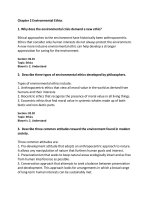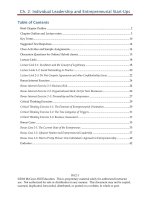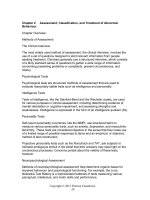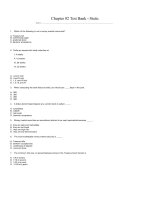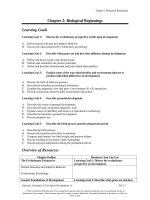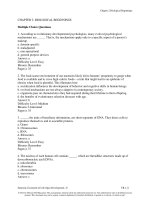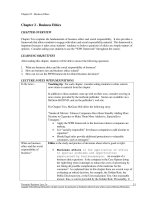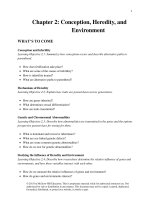Test bank and solution manual of CH02 descritive statistics (2)
Bạn đang xem bản rút gọn của tài liệu. Xem và tải ngay bản đầy đủ của tài liệu tại đây (878.83 KB, 42 trang )
Chapter 2
Descriptive Statistics: Tabular and
Graphical Displays
Learning Objectives
1.
Learn how to construct and interpret summarization procedures for qualitative data such as:
frequency and relative frequency distributions, bar graphs and pie charts.
2.
Learn how to construct and interpret tabular summarization procedures for quantitative data such as:
frequency and relative frequency distributions, cumulative frequency and cumulative relative
frequency distributions.
3.
Learn how to construct a dot plot and a histogram as graphical summaries of quantitative data.
4.
Learn how the shape of a data distribution is revealed by a histogram. Learn how to recognize when
a data distribution is negatively skewed, symmetric, and positively skewed.
5.
Be able to use and interpret the exploratory data analysis technique of a stem-and-leaf display.
6.
Learn how to construct and interpret cross tabulations, scatter diagrams, side-by-side and stacked bar
charts.
7.
Learn best practices for creating effective graphical displays and for choosing the appropriate type of
display.
2-1
© 2014 Cengage Learning. All Rights Reserved.
May not be scanned, copied or duplicated, or posted to a publicly accessible website, in whole or in part.
Chapter 2
Solutions:
1.
Class
A
B
C
2.
Frequency
60
24
36
120
a.
1 – (.22 + .18 + .40) = .20
b.
.20(200) = 40
Relative Frequency
60/120 = 0.50
24/120 = 0.20
36/120 = 0.30
1.00
c/d.
Class
A
B
C
D
Total
3.
a.
360° x 58/120 = 174°
b.
360° x 42/120 = 126°
Frequency
.22(200) = 44
.18(200) = 36
.40(200) = 80
.20(200) = 40
200
Percent Frequency
22
18
40
20
100
c.
No Opinion
16.7%
No
35.0%
Yes
48.3%
2-2
© 2014 Cengage Learning. All Rights Reserved.
May not be scanned, copied or duplicated, or posted to a publicly accessible website, in whole or in part.
Descriptive Statistics: Tabular and Graphical Displays
d.
70
60
Frequency
50
40
30
20
10
0
Yes
No
No Opinion
Response
a.
These data are categorical.
b.
Show
Jep
Relative
Frequency
% Frequency
10
20
JJ
8
16
OWS
7
14
THM
12
24
WoF
13
26
Total
50
100
c.
14
12
10
Frequency
4.
8
6
4
2
0
Jep
JJ
OWS
THM
Syndicated Television Show
WoF
2-3
© 2014 Cengage Learning. All Rights Reserved.
May not be scanned, copied or duplicated, or posted to a publicly accessible website, in whole or in part.
Chapter 2
Syndicated Television Shows
Jep
20%
WoF
26%
JJ
16%
THM
24%
d.
The largest viewing audience is for Wheel of Fortune and the second largest is for Two and a Half
Men.
a.
Relative
Percent
Frequency
Frequency
Frequency
Brown
7
0.14
14%
Johnson
10
0.20
20%
Jones
7
0.14
14%
Miller
6
0.12
12%
Smith
12
0.24
24%
8
0.16
16%
50
1
100%
Name
Williams
Total:
b.
Common U.S. Last Names
14
12
Frequency
5.
OWS
14%
10
8
6
4
2
0
Brown
Johnson
Jones
Miller
Name
Smith
Williams
2-4
© 2014 Cengage Learning. All Rights Reserved.
May not be scanned, copied or duplicated, or posted to a publicly accessible website, in whole or in part.
Descriptive Statistics: Tabular and Graphical Displays
c.
Common U.S. Last Names
Brown
14%
Williams
16%
Johnson
20%
Smith
24%
d.
a.
Relative
Network
Frequency
6.
Jones
14%
Miller
12%
The three most common last names are Smith (24%), Johnson (20%), and Williams (16%)
Frequency
% Frequency
ABC
6
24
CBS
9
36
FOX
1
4
NBC
9
36
Total:
25
100
10
9
8
7
6
5
4
3
2
1
0
ABC
CBS
FOX
NBC
Network
b.
For these data, NBC and CBS tie for the number of top-rated shows. Each has 9 (36%) of the top 25.
ABC is third with 6 (24%) and the much younger FOX network has 1(4%).
2-5
© 2014 Cengage Learning. All Rights Reserved.
May not be scanned, copied or duplicated, or posted to a publicly accessible website, in whole or in part.
Chapter 2
7.
a.
Rating
Excellent
Very Good
Good
Fair
Poor
Frequency
20
23
4
1
2
50
Percent Frequency
40
46
8
2
4
100
50
45
Percent Frequency
40
35
30
25
20
15
10
5
0
Poor
Fair
Good
Very Good
Customer Rating
Excellent
Management should be very pleased with the survey results. 40% + 46% = 86% of the ratings are
very good to excellent. 94% of the ratings are good or better. This does not look to be a Delta flight
where significant changes are needed to improve the overall customer satisfaction ratings.
b.
8.
While the overall ratings look fine, note that one customer (2%) rated the overall experience with the
flight as Fair and two customers (4%) rated the overall experience with the flight as Poor. It might
be insightful for the manager to review explanations from these customers as to how the flight failed
to meet expectations. Perhaps, it was an experience with other passengers that Delta could do little
to correct or perhaps it was an isolated incident that Delta could take steps to correct in the future.
a.
Position
Pitcher
Catcher
1st Base
2nd Base
3rd Base
Shortstop
Left Field
Center Field
Right Field
b.
Pitchers (Almost 31%)
c.
3rd Base (3 – 4%)
Frequency
17
4
5
4
2
5
6
5
7
55
Relative Frequency
0.309
0.073
0.091
0.073
0.036
0.091
0.109
0.091
0.127
1.000
2-6
© 2014 Cengage Learning. All Rights Reserved.
May not be scanned, copied or duplicated, or posted to a publicly accessible website, in whole or in part.
Descriptive Statistics: Tabular and Graphical Displays
Right Field (Almost 13%)
e.
Infielders (16 or 29.1%) to Outfielders (18 or 32.7%)
b.
Living Area
City
Suburb
Small Town
Rural Area
Total
Live Now
32%
26%
26%
16%
100%
Ideal Community
24%
25%
30%
21%
100%
Where do you live now?
35%
30%
25%
Percent
a.
20%
15%
10%
5%
0%
City
Suburb
Small Town
Living Area
Rural Area
What do you consider the ideal community?
35%
30%
25%
Percent
9.
d.
20%
15%
10%
5%
0%
City
Suburb
Small Town
Ideal Community
Rural Area
2-7
© 2014 Cengage Learning. All Rights Reserved.
May not be scanned, copied or duplicated, or posted to a publicly accessible website, in whole or in part.
Chapter 2
c.
Most adults are now living in a city (32%).
d.
Most adults consider the ideal community a small town (30%).
e.
Percent changes by living area: City –8%, Suburb –1%, Small Town +4%, and Rural Area +5%.
Suburb living is steady, but the trend would be that living in the city would decline while
living in small towns and rural areas would increase.
10. a.
Rating
Frequency
Excellent
187
Very Good
252
Average
107
Poor
62
Terrible
41
Total
649
Rating
Percent
Frequency
b.
Excellent
28.8
Very Good
38.8
Average
16.5
Poor
9.6
Terrible
6.3
Total
100.0
c.
45
Percent Frequency
40
35
30
25
20
15
10
5
0
Excellent
d.
Very Good
Average
Rating
Poor
Terrible
28.8% + 38.8 = 67.6% of the guests at the Sheraton Anaheim Hotel rated the hotel as Excellent or
Very Good. But, 9.6% + 6.3% = 15.9% of the guests rated the hotel as poor or terrible.
2-8
© 2014 Cengage Learning. All Rights Reserved.
May not be scanned, copied or duplicated, or posted to a publicly accessible website, in whole or in part.
Descriptive Statistics: Tabular and Graphical Displays
e.
The percent frequency distribution for Disney’s Grand Californian follows:
Percent
Frequency
Rating
Excellent
48.1
Very Good
31.0
Average
11.9
Poor
6.4
Terrible
2.6
Total
100.0
48.1% + 31.0% = 79.1% of the guests at the Sheraton Anaheim Hotel rated the hotel as Excellent or
Very Good. And, 6.4% + 2.6% = 9.0% of the guests rated the hotel as poor or terrible.
Compared to ratings of other hotels in the same region, both of these hotels received very favorable
ratings. But, in comparing the two hotels, guests at Disney’s Grand Californian provided somewhat
better ratings than guests at the Sheraton Anaheim Hotel.
11.
Class
12–14
15–17
18–20
21–23
24–26
Total
Frequency
2
8
11
10
9
40
Relative Frequency
0.050
0.200
0.275
0.250
0.225
1.000
Percent Frequency
5.0
20.0
27.5
25.0
22.5
100.0
12.
Class
less than or equal to 19
less than or equal to 29
less than or equal to 39
less than or equal to 49
less than or equal to 59
Cumulative Frequency
10
24
41
48
50
Cumulative Relative Frequency
.20
.48
.82
.96
1.00
2-9
© 2014 Cengage Learning. All Rights Reserved.
May not be scanned, copied or duplicated, or posted to a publicly accessible website, in whole or in part.
Chapter 2
13.
18
16
14
Frequency
12
10
8
6
4
2
0
10-19
20-29
30-39
40-49
50-59
14. a.
b/c.
Class
6.0 – 7.9
8.0 – 9.9
10.0 – 11.9
12.0 – 13.9
14.0 – 15.9
15.
Frequency
4
2
8
3
3
20
Percent Frequency
20
10
40
15
15
100
Leaf Unit = .1
6
3
7
5 5 7
8
1 3 4 8
9
3 6
10
0 4 5
11
3
2 - 10
© 2014 Cengage Learning. All Rights Reserved.
May not be scanned, copied or duplicated, or posted to a publicly accessible website, in whole or in part.
Descriptive Statistics: Tabular and Graphical Displays
16.
Leaf Unit = 10
11
6
12
0 2
13
0 6 7
14
2 2 7
15
5
16
0 2 8
17
0 2 3
17. a/b.
Waiting Time
0–4
5–9
10 – 14
15 – 19
20 – 24
Totals
Frequency
4
8
5
2
1
20
Relative Frequency
0.20
0.40
0.25
0.10
0.05
1.00
c/d.
Waiting Time
Less than or equal to 4
Less than or equal to 9
Less than or equal to 14
Less than or equal to 19
Less than or equal to 24
e.
Cumulative Frequency
4
12
17
19
20
Cumulative Relative Frequency
0.20
0.60
0.85
0.95
1.00
12/20 = 0.60
18. a., b, c
Cumulative
Percent
Frequency
2
PPG
Frequency
10-11.9
1
Relative
Frequency
.02
12-13.9
3
.06
8
14-15.9
7
.14
22
16-17.9
19
.38
60
18-19.9
9
.18
78
20-21.9
4
.08
86
22-23.9
2
.04
90
24-25.9
0
.00
90
26-27.9
3
.06
96
28-29.9
2
.04
100
Total
50
2 - 11
© 2014 Cengage Learning. All Rights Reserved.
May not be scanned, copied or duplicated, or posted to a publicly accessible website, in whole or in part.
Chapter 2
d.
20
18
16
Frequency
14
12
10
8
6
4
2
0
10-11.9 12-13.9 14-15.9 16-17.9 18-19.9 20-21.9 22-23.9 24-25.9 26-27.9
28-30
PPG
e.
There is skewness to the right.
f.
(11/50)(100) = 22%
19. a.
The largest number of tons is 236.3 million (South Louisiana). The smallest number of tons is 30.2
million (Port Arthur).
b.
Millions Of Tons
Frequency
25-50
11
50-75
9
75-100
2
100-125
0
125-150
1
150-175
0
175-200
0
200-225
0
225-250
2
2 - 12
© 2014 Cengage Learning. All Rights Reserved.
May not be scanned, copied or duplicated, or posted to a publicly accessible website, in whole or in part.
Descriptive Statistics: Tabular and Graphical Displays
c.
Histogram for 25 Busiest U.S Ports
12
Frequency
10
8
6
4
2
0
25-49.9
50-74.9
75-99.9
100-124.9 125-149.9 150-174.9 175-199.9 200-224.9 225-249.9
Millions of Tons Handled
Most of the top 25 ports handle less than 75 million tons. Only five of the 25 ports handle above 75
million tons.
20. a.
Lowest = 12, Highest = 23
b.
Hours in
Meetings per Week
Frequency
Percent
Frequency
11-12
1
4%
13-14
2
8%
15-16
6
24%
17-18
3
12%
19-20
5
20%
21-22
4
16%
23-24
4
16%
25
100%
2 - 13
© 2014 Cengage Learning. All Rights Reserved.
May not be scanned, copied or duplicated, or posted to a publicly accessible website, in whole or in part.
Chapter 2
c.
7
6
Fequency
5
4
3
2
1
0
11-12
13-14
15-16
17-18
19-20
21-22
23-24
Hours per Week in Meetings
The distribution is slightly skewed to the left.
21. a/b/c/d.
Revenue
0-49
50-99
100-149
150-199
200-249
250-299
300-349
350-399
400-449
Total
e.
Frequency
6
29
11
0
1
1
0
0
2
50
Relative
Frequency
.12
.58
.22
.00
.02
.02
.00
.00
.04
1.00
Cumulative
Frequency
6
35
46
46
47
48
48
48
50
Cumulative Relative
Frequency
.12
.70
.92
.92
.94
.96
.96
.96
1.00
The majority of the large corporations (40) have revenues in the $50 billion to $149 billion range.
Only 4 corporations have revenues of over $200 billion and only 2 corporations have revenues over
$400 billion. .70, or 70%, of the corporations have revenues under $100 billion. .30, or 30%, of the
corporations have revenues of $100 billion or more.
2 - 14
© 2014 Cengage Learning. All Rights Reserved.
May not be scanned, copied or duplicated, or posted to a publicly accessible website, in whole or in part.
Descriptive Statistics: Tabular and Graphical Displays
f.
35
30
Frequency
25
20
15
10
5
0
0-49
50-99
100-149
150-199
200-249
250-299
300-349
350-399
400-449
Revenue (Billion $)
The histogram shows the distribution is skewed to the right with four corporations in the $200 to
$449 billion range.
g.
Exxon-Mobil is America’s largest corporation with an annual revenue of $443 billion. Wal-Mart is
the second largest corporation with annual revenue of $406 billion. All other corporations have
annual revenues less than $300 billion. Most (92%) have annual revenues less than $150 billion.
22. a.
# U.S.
Locations
Frequency
Percent
Frequency
0-4999
10
50
5000-9999
3
15
10000-14999
2
10
15000-19999
1
5
20000-24999
0
0
25000-29999
1
5
30000-34999
2
10
35000-39999
1
5
Total:
20
100
2 - 15
© 2014 Cengage Learning. All Rights Reserved.
May not be scanned, copied or duplicated, or posted to a publicly accessible website, in whole or in part.
Chapter 2
b.
12
Frequency
10
8
6
4
2
0
Number of U.S. Locations
c.
The distribution is skewed to the right. The majority of the franchises in this list have fewer than
20,000 locations (50% + 15% + 15% = 80%). McDonald's, Subway and 7-Eleven have the highest
number of locations.
23. a/b.
Computer
Usage (Hours)
0.0 – 2.9
3.0 – 5.9
6.0 – 8.9
9.0 – 11.9
12.0 – 14.9
Total
Relative
Frequency
0.10
0.56
0.16
0.12
0.06
1.00
Frequency
5
28
8
6
3
50
c.
30
Frequency
25
20
15
10
5
0
0-2.9
3-5.9
6-8.9
9-11.9
12-14.9
Computer Usage (Hours)
d.
The majority of the computer users are in the 3 to 6 hour range. Usage is somewhat skewed toward
the right with 3 users in the 12 to 14.9 hour range.
2 - 16
© 2014 Cengage Learning. All Rights Reserved.
May not be scanned, copied or duplicated, or posted to a publicly accessible website, in whole or in part.
Descriptive Statistics: Tabular and Graphical Displays
24.
Median Pay
6
6 7 7
7
2 4 6 7 7 8 9
8
0 0 1 3 7
9
9
10
0 6
11
0
12
1
The median pay for these careers is generally in the $70 and $80 thousands. Only four careers have
a median pay of $100 thousand or more. The highest median pay is $121 thousand for a finance
director.
Top Pay
10
0 6 9
11
1 6 9
12
2 5 6
13
0 5 8 8
14
0 6
15
2 5 7
16
17
18
19
20
21
4
22
1
The most frequent top pay is in the $130 thousand range. However, the top pay is rather evenly
distributed between $100 and $160 thousand. Two unusually high top pay values occur at $214
thousand for a finance director and $221 thousand for an investment banker. Also, note that the top
pay has more variability than the median pay.
2 - 17
© 2014 Cengage Learning. All Rights Reserved.
May not be scanned, copied or duplicated, or posted to a publicly accessible website, in whole or in part.
Chapter 2
25.
9
8 9
10
2 4 6 6
11
4 5 7 8 8 9
12
2 4 5 7
13
1 2
14
4
15
1
2
1 4
2
6 7
3
0 1 1 1 2 3
3
5 6 7 7
4
0 0 3 3 3 3 3 4 4
4
6 6 7 9
5
0 0 0 2 2
5
5 6 7 9
6
1 4
6
6
7
2
26. a.
b.
Most frequent age group: 40-44 with 9 runners
c.
43 was the most frequent age with 5 runners
27. a.
y
x
1
2
Total
A
5
0
5
B
11
2
13
C
2
10
12
Total
18
12
30
2 - 18
© 2014 Cengage Learning. All Rights Reserved.
May not be scanned, copied or duplicated, or posted to a publicly accessible website, in whole or in part.
Descriptive Statistics: Tabular and Graphical Displays
b.
y
x
1
2
Total
A
100.0
0.0
100.0
B
84.6
15.4
100.0
C
16.7
83.3
100.0
c.
y
1
2
A
27.8
0.0
B
61.1
16.7
C
11.1
83.3
Total
100.0
100.0
x
d.
Category A values for x are always associated with category 1 values for y. Category B values for x
are usually associated with category 1 values for y. Category C values for x are usually associated
with category 2 values for y.
28. a.
20-39
x
10-29
30-49
50-69
70-90
Grand Total
2
1
4
7
3
y
60-79
1
4
1
3
6
40-59
80-100
4
4
Grand Total
5
6
5
4
20
b.
x
10-29
30-49
50-69
70-90
20-39
40-59
33.3
20.0
100.0
60.0
y
60-79
20.0
66.7
20.0
80-100
80.0
Grand Total
100
100
100
100
2 - 19
© 2014 Cengage Learning. All Rights Reserved.
May not be scanned, copied or duplicated, or posted to a publicly accessible website, in whole or in part.
Chapter 2
c.
20-39
0.0
28.6
14.3
57.1
100
10-29
30-49
50-69
70-90
Grand Total
x
d.
y
60-79
16.7
66.7
16.7
0.0
100
40-59
0.0
0.0
100.0
0.0
100
80-100
100.0
0.0
0.0
0.0
100
Higher values of x are associated with lower values of y and vice versa
29. a.
Average Miles per Hour
Make
130-139.9
Buick
100.00
0.00
0.00
18.75
31.25
0.00
33.33
Chevrolet
Dodge
Ford
b.
140-149.9
150-159.9
160-169.9
170-179.9
Total
0.00
0.00
100.00
25.00
18.75
6.25
100.00
100.00
0.00
0.00
0.00
100.00
16.67
33.33
16.67
0.00
100.00
25.00 + 18.75 + 6.25 = 50 percent
c.
Average Miles per Hour
Make
130-139.9
140-149.9
150-159.9
160-169.9
170-179.9
Buick
16.67
0.00
0.00
0.00
0.00
Chevrolet
50.00
62.50
66.67
75.00
100.00
0.00
25.00
0.00
0.00
0.00
Ford
33.33
12.50
33.33
25.00
0.00
Total
100.00
100.00
100.00
100.00
100.00
Dodge
d.
75%
30. a.
Year
Average Speed
1988-1992
1993-1997
1998-2002
2003-2007
2008-2012
130-139.9
16.7
0.0
0.0
33.3
50.0
100
140-149.9
25.0
25.0
12.5
25.0
12.5
100
150-159.9
0.0
50.0
16.7
16.7
16.7
100
160-169.9
50.0
0.0
50.0
0.0
0.0
100
170-179.9
0.0
0.0
100.0
0.0
0.0
100
b.
Total
It appears that most of the faster average winning times occur before 2003. This could be due to new
regulations that take into account driver safety, fan safety, the environmental impact, and fuel
consumption during races.
2 - 20
© 2014 Cengage Learning. All Rights Reserved.
May not be scanned, copied or duplicated, or posted to a publicly accessible website, in whole or in part.
Descriptive Statistics: Tabular and Graphical Displays
31. a.
The crosstabulation of condition of the greens by gender is below.
Green Condition
Too Fast
Fine
35
65
40
60
75
125
Gender
Male
Female
Total
Total
100
100
200
The female golfers have the highest percentage saying the greens are too fast: 40/100 = 40%. Male
golfers have 35/100 = 35% saying the greens are too fast.
b.
Among low handicap golfers, 1/10 = 10% of the women think the greens are too fast and 10/50 =
20% of the men think the greens are too fast. So, for the low handicappers, the men show a higher
percentage who think the greens are too fast.
c.
Among the higher handicap golfers, 39/51 = 43% of the woman think the greens are too fast and
25/50 = 50% of the men think the greens are too fast. So, for the higher handicap golfers, the men
show a higher percentage who think the greens are too fast.
d.
This is an example of Simpson's Paradox. At each handicap level a smaller percentage of the women
think the greens are too fast. But, when the crosstabulations are aggregated, the result is reversed and
we find a higher percentage of women who think the greens are too fast.
The hidden variable explaining the reversal is handicap level. Fewer people with low handicaps
think the greens are too fast, and there are more men with low handicaps than women.
32. a.
5 Year Average Return
.
Fund Type
0-9.99
DE
1
FI
b.
c.
d.
9
10-19.99 20-29.99 30-39.99
25
1
1
0
50-59.99
Total
0
40-49.99
0
0
27
0
0
0
10
1
8
1
45
IE
0
2
3
2
0
Total
10
28
4
2
0
5 Year Average Return
0-9.99
10-19.99
20-29.99
30-39.99
40-49.99
50-59.99
Total
Fund Type
Frequency
DE
27
FI
10
IE
8
Total
45
Frequency
10
28
4
2
0
1
45
The right margin shows the frequency distribution for the fund type variable and the bottom margin
shows the frequency distribution for the 5 year average return variable.
2 - 21
© 2014 Cengage Learning. All Rights Reserved.
May not be scanned, copied or duplicated, or posted to a publicly accessible website, in whole or in part.
Chapter 2
e.
Higher returns are associated with International Equity funds and lower returns are associated with
Fixed Income funds.
33. a.
Expense Ratio (%)
Fund Type
0-0.24 0.25-0.49 0.50-0.74 0.75-0.99 1.00-1.24 1.25-1.49
Total
DE
1
1
3
5
10
7
27
FI
2
4
3
0
0
1
10
IE
0
0
1
2
4
1
8
Total
3
5
7
7
14
9
45
b.
Expense Ratio (%)
0-0.24
0.25-0.49
0.50-0.74
0.75-0.99
1.00-1.24
1.25-1.49
Total
c.
Frequency
3
5
7
7
14
9
45
Percent
6.7
11.1
15.6
15.6
31.0
20.0
100
Higher expense ratios are associated with Domestic Equity funds and lower expense ratios are
associated with Fixed Income fund
2 - 22
© 2014 Cengage Learning. All Rights Reserved.
May not be scanned, copied or duplicated, or posted to a publicly accessible website, in whole or in part.
Descriptive Statistics: Tabular and Graphical Displays
34. a.
b.
The top three states for bankruptcies over this time period are Georgia (86), Florida (69) and Illinois
(58).
c.
The frequency distribution over time appears below. Bank failures surged in 2009 and 2010 and then
began decreasing in 2011 and 2012.
2 - 23
© 2014 Cengage Learning. All Rights Reserved.
May not be scanned, copied or duplicated, or posted to a publicly accessible website, in whole or in part.
Chapter 2
Number of
Year
Bank Failures
2000
2
2001
4
2002
11
2003
3
2004
4
2005
0
2006
0
2007
3
2008
25
2009
140
2010
157
2011
92
2012
51
35. a.
Size
Compact
Large
Midsize
Total
b.
c.
Hwy MPG
25-29 30-34
17
22
7
3
30
20
54
45
20-24
4
10
4
18
35-39
5
2
9
16
40-44
5
3
8
Total
56
24
69
149
Midsize and Compact seem to be more fuel efficient than Large.
Drive
A
F
R
Total
d.
15-19
3
2
3
8
10-14
7
15-19
18
17
20
55
10
17
City MPG
20-24
3
49
52
25-29
30-34
40-44
19
1
20
2
3
2
3
Total
28
90
31
149
Higher fuel efficiencies are associated with front wheel drive cars.
e.
Fuel Type
P
R
Total
f.
15-19
8
8
20-24
16
2
18
City MPG
25-29
20
34
54
30-34
12
33
45
35-39
40-44
16
16
8
8
Total
56
93
149
Higher fuel efficiencies are associated with cars that use regular gas.
2 - 24
© 2014 Cengage Learning. All Rights Reserved.
May not be scanned, copied or duplicated, or posted to a publicly accessible website, in whole or in part.
Descriptive Statistics: Tabular and Graphical Displays
36. a.
56
40
24
y
8
-8
-24
-40
-40
-30
-20
-10
0
10
20
30
40
x
b.
There is a negative relationship between x and y; y decreases as x increases.
37. a.
900
800
700
600
500
400
300
200
I
II
100
0
A
b.
B
C
D
As X goes from A to D the frequency for I increases and the frequency of II decreases.
38. a.
y
x
Yes
No
Low
66.667
33.333
100
Medium
30.000
70.000
100
High
80.000
20.000
100
2 - 25
© 2014 Cengage Learning. All Rights Reserved.
May not be scanned, copied or duplicated, or posted to a publicly accessible website, in whole or in part.
